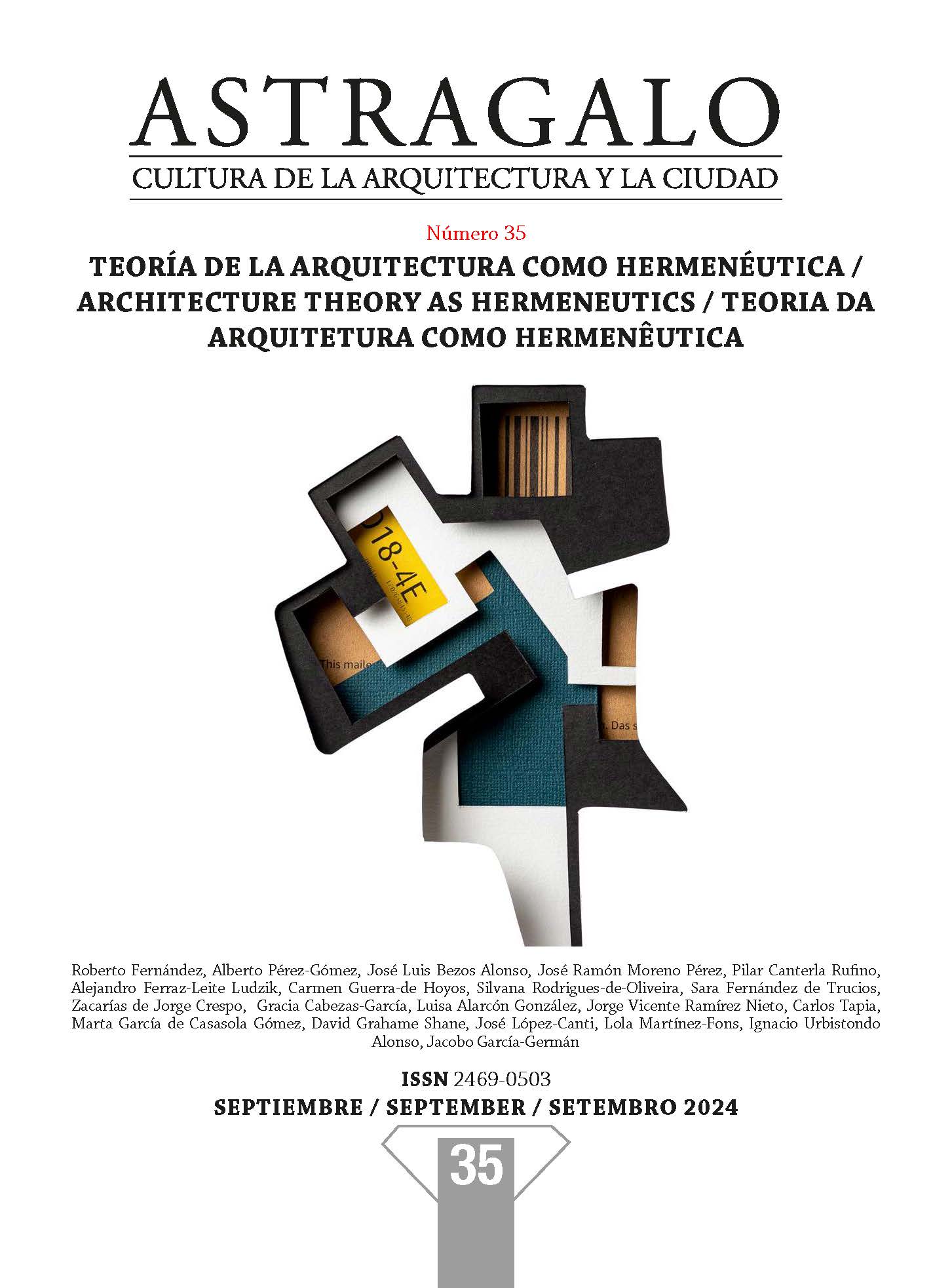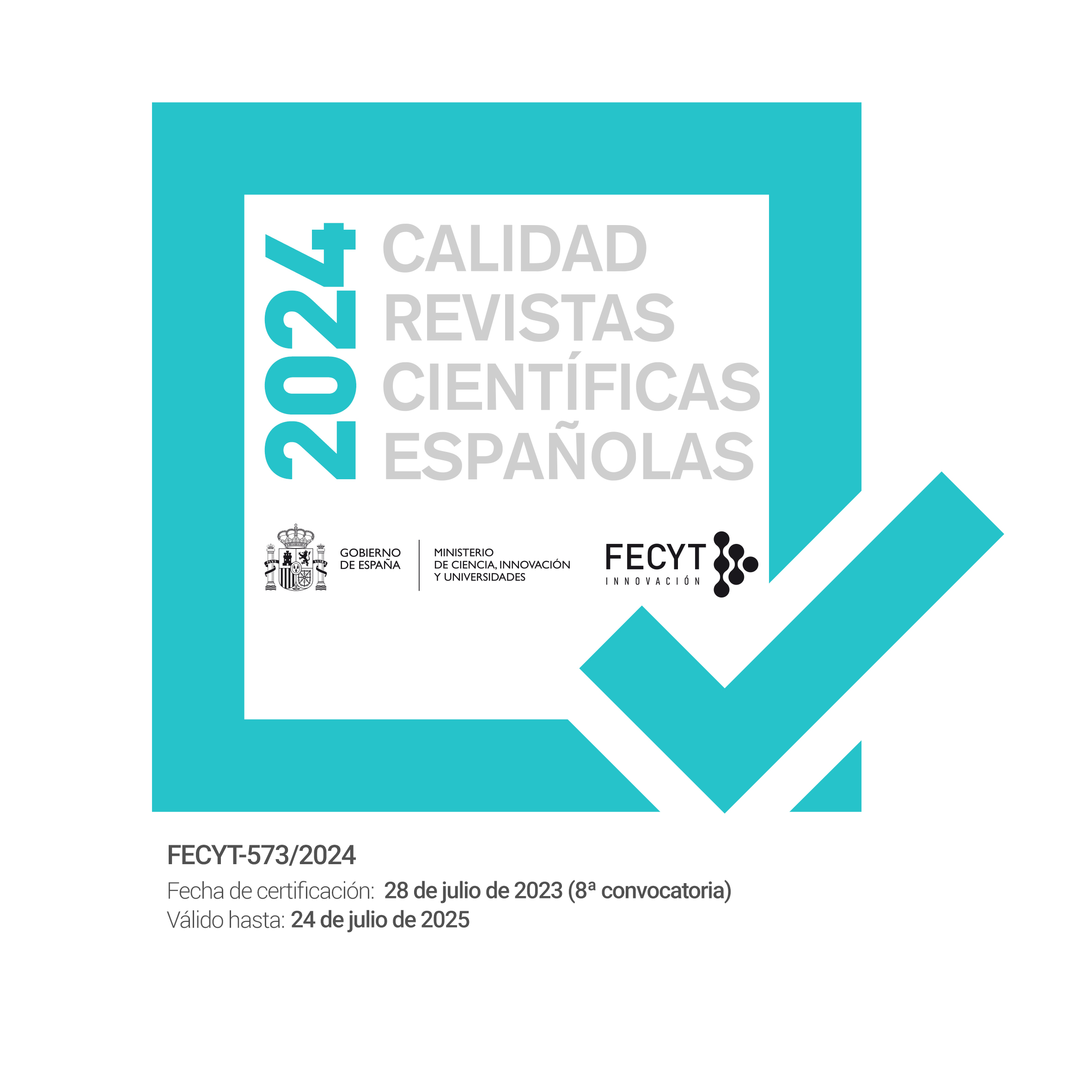Venice, dream and (architectural) phenomenon, still.
DOI:
https://doi.org/10.12795/astragalo.2024.i35.05Keywords:
phenomenology, Venice, experience, light, dreamAbstract
The city of Venice is a mythical setting, where experience is the focus of literary, artistic and architectural production about the city. Light plays a crucial role in the understanding and representation of its spaces, inspiring artists —such as Turner or Monet— who tried to capture its essence, representing not only a physical reality, but also emotional and psychological states. A myriad of scenarios that are repeated in most of the representations of the city and that make us think about how the same event can be materialised an infinite number of times even under different modalities, creating a kind of collective dream through an exclusively sensorial perception of Venice. Breaking out of this dream implies breaking an important cultural barrier and challenging the traditional notion of the subject as a mere passive observer. A step to take in order to rethink the city and move away from a reality that is already exhausted and inundated by clichés and sentimentality. This article will explore the possibility of extending the validity of Heideggerian phenomenology to architectural thought precisely because of the capacity of this Venetian city to provide symptoms of contemporaneity even in its long decadence.
Downloads
References
Bachelard, Gastón. 2003. El agua y los sueños. 4th ed. México D.F.: Fondo de Cultura Económica.
Bedford, Joseph. 2018. “Toward Rethinking The Politics of Phenomenology In Architecture.” Log, no. 42: 181–85. http://www.jstor.org/stable/44840740.
Berry, Kevin. 2018. “Heidegger and The Architecture Of Projective Involvement.” Log, no. 42: 103–15. http://www.jstor.org/stable/44840732.
Böhme, Gernot. 2014. “Light and Space. On the Phenomenology of Light.” Dialogue and Universalism 24 (January): 62–73. https://doi.org/10.5840/du201424491.
Borda Lapébie, Juan Miguel. 2002. “La ciudad de Venecia vista por cinco novelistas franceses.” Espéculo: Revista de estudios literarios, no. 22. https://dialnet.unirioja.es/servlet/extart?codigo=496218.
Brown, Adrienne. 2018. “The Architecture of Racial Phenomena.” Log, no. 42: 27–33. http://www.jstor.org/stable/44840725.
Calvino, Italo. 2005. Las ciudades invisibles. 11th ed. Madrid: Ediciones Siruela. [1972]
Collaku, Fatlind. 2022. “Perception and Memory of Urban Space: A Psychogeographical Study of the Cannaregio District in Venice.” ARC I - Scuola di Architettura Urbanistica Ingegneria delle Costruzioni.
Constable, W G. 1929. “Canaletto at the Magnasco Society.” The Burlington Magazine for Connoisseurs 55 (316): 46–50. http://www.jstor.org/stable/864080.
Corral Del Campo, Francisco José Del. 2008. “Las formas del agua y la arquitectura de Carlo Scarpa.” http://hdl.handle.net/10481/1841.
Foscari, Giulia. 2014. Elements of Venice.
Frascari, Marco. 1988. “The Lume Materiale in the Architecture of Venice.” Perspecta 24: 137–45. https://doi.org/10.2307/1567130.
Freud, Sigmund. 1991. La interpretación de los sueños. Vol. 5. Buenos Aires: Amorrortu Editores.
Gaya, Ramón. 2010. Obra completa. Editado por Nigel Dennis e Isabel Verdejo. Valencia-Madrid: Editorial Pre-Textos.
George, Hardy. 1971. “Turner in Venice.” The Art Bulletin 53 (1): 84–87. https://doi.org/10.2307/3048800.
Gertz, Nolen. 2010. “On the Possibility of a Phenomenology of Light” 5 (10): 41–58. https://doi.org/10.22329/p.v5i1.2852.
Heidegger, Martin. 1994. Conferencias y artículos. 1st ed. Barcelona: Ediciones del Serbal.
Jelić, Andrea, and Aleksandar Staničić. 2022. “Embodiment and Meaning-Making: Interdisciplinary Perspectives on Heritage Architecture.” The Journal of Architecture 27 (4): 473–84. https://doi.org/10.1080/13602365.2022.2132769.
Kretzulesco-Quaranta, Emanuela. 2005. Los jardines del sueño. Polifilo y la mística del Renacimiento. Ediciones Siruela. Madrid.
Ladrón de Guevara Mellado, Pedro Luis, María Belén (coord.) Hernández González, and Carmen María (coord.) Pujante Segura. 2021. “Italia en los textos de Ramón Gaya: Epistolario y escritos.” Monteagudo: Revista de Literatura española, hispanoamericana y Teoría de la literatura, no. 26: 137–59. https://dialnet.unirioja.es/servlet/extart?codigo=7897947.
Marinetti, Filippo Tommaso. 1914. “Contro Venezia passatista.” In I Manifesti del Futurismo, 32–36. Florencia: Lacerba.
Merleau-Ponty, Maurice. 1964. “The Film and the New Psychology.” In Sense and Non-Sense, 48–60. Evanston: Northwestern University Press.
Mitrović, Branko. 2018. “Phenomenology, Architecture and the Writing of Architectural History.” Journal of Art Historiography, no. 19: 1–27.
Mohrt, Michel. 1996. Les dimanches de Venise. París: Gallimard, Col. Folio.
Morand, Paul. 1971. Venises. París: Gallimard, Col. L’imaginaire.
Nehamas, Alexander, y Juan Edilberto Rendón Ángel. 2010. “El sueño de la razón produce monstruos.” Katharsis: Revista de ciencias sociales, no. 10: 7–32. https://dialnet.unirioja.es/servlet/extart?codigo=5527410.
Norwood, Bryan E, y Jorge Otero-Pailos. 2018. “An Interview with Jorge Otero-Pailos.” Log, no. 42: 136–44. http://www.jstor.org/stable/44840735.
Otero-Pailos, Jorge. 2010. Phenomenology and the Rise of the Postmodern. NED-New edition. University of Minnesota Press. http://www.jstor.org/stable/10.5749/j.cttttvjt.
Pallasmaa, J. 1994. Space and Image in Andrei Tarkovsky’s Nostalgia: Notes on a Phenomenology of Architecture. Bookitem. Chora1: Intervals in the Philosophy of Architecture. Montreal: McGill-Queen’s University Press.
Pallasmaa, Juhani. 2014. “Space, Place and Atmosphere. Emotion and Peripherical Perception in Architectural Experience.” Lebenswelt: Aesthetics and Philosophy of Experience, July. https://doi.org/10.13130/2240-9599/4202.
Pallasmaa, Juhani, and Rodrigo Garcia Alvarado. 2009. “Tocando el mundo: Espacio vivencial, visión y hapticidad.” Arquitecturas del Sur 27 (36): 80–93. https://dialnet.unirioja.es/servlet/extart?codigo=5231458.
Platón. 1872. Obras completas de Platón / Puestas en lengua castellana por primera vez por Patricio de Azcárate. Tomo VIII. Madrid: Medina y Navarro.
Proust, Marcel. 1947. À la recherche du temps perdu. Vol. VIII. París: Gallimard.
Ridgway, Sam. 2005. “The Imagination of Construction.” Architectural Research Quarterly 9 (3–4): 189–96. https://doi.org/DOI: 10.1017/S1359135505000254.
Rousseau, Jean-Jacques. 1998. Las ensoñaciones del paseante solitario. 3rd ed. Madrid: Alianza Editorial.
Ruskin, John. 1913. Las piedras de Venecia. Tomo Primero. Valencia: F. Sempere y Compañía, Editores. https://www.cervantesvirtual.com/nd/ark:/59851/bmc1071993.
Sioli, Angeliki. 2022. “Watermarks of Architecture.” The Journal of Architecture 27 (4): 500–516. https://doi.org/10.1080/13602365.2022.2122068.
Sloterdijk, Peter. 2017. Estrés y libertad. Ciudad Autónoma de Buenos Aires: Ediciones Godot.
Theodore, David. 2018. “Turning Architecture Upside-down: From Inigo Jones To Phenomenology.” Log, no. 42: 116–26. http://www.jstor.org/stable/44840733.
Valcárcel Pérez, José Luis. 2015. “Ramón Gaya: pintura, ensayo, poesía.” Proyecto de investigación, Abril. https://digitum.um.es/digitum/handle/10201/44094.
Downloads
Published
How to Cite
Issue
Section
License
Copyright (c) 2024 María del Pilar Canterla Rufino

This work is licensed under a Creative Commons Attribution-NonCommercial-ShareAlike 4.0 International License.


















